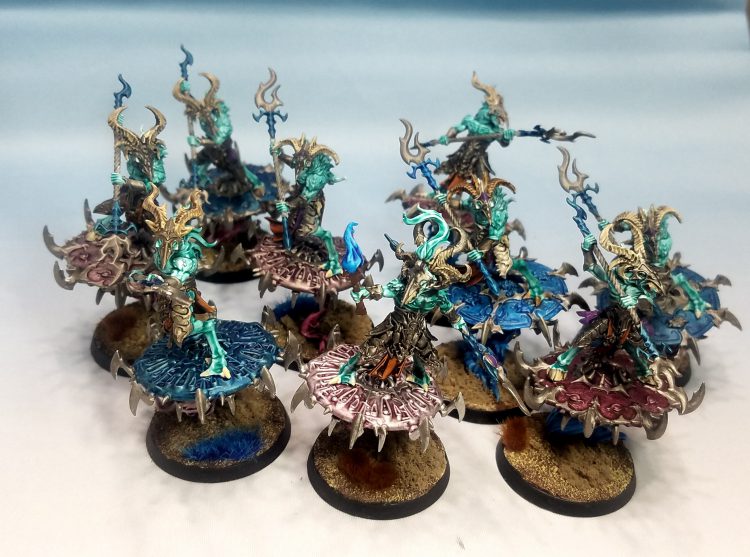In our How to Paint Everything series, we take a look at different armies of the Warhammer universe, examine their history and heraldry, and look at several different methods for painting them. In this week’s article, we’re looking at the twisted bestial followers of Tzeentch, Tzaangors.
Who (or What) are Tzaangors?
Tzaangors are essentially the flavor of beastman gors who are devoted to Tzeentch, the changer of ways. Whether by choice, by random mutation and the whims of the dark god, or by twisted birth, Tzaangors typically have a much more birdlike form, and will often have beaks and feathers in addition to horns, fur, and taloned appendages. They tend to be a bit smarter and more cunning than their counterparts devoted to the other Chaos gods, and think of themselves as superior. Tzaangor pack leaders are called Twistbrays.
In the Age of Sigmar, Tzaangors live in the wild places of the Mortal Realms (in pretty much all of them), and usually opt to live in areas rich in magic, where they’ll erect rune-carved Herdstones in an effort to slowly warp the land around them. Age of Sigmar Tzaangors are divided into two major groups: The Enlightened, who carry spears of wrought change-metal and can see into the past through magical means, and the Skyfires, who ride around on Discs of Tzeentch and can see potential futures, but can’t talk about them.
In the universe of Warhammer 40,000, Tzaangors are native to the Planet of Sorcerers, twisted by the machinations of Tzeentch. Upon the arrival of the Thousand Sons to the planet, most of them were captured and enslaved, forced to work as thralls to the legion. Those that managed to escape established their own free society, roaming in great packs led by Tzaangor Shamans.

Tzaangors are kind of an odd addition to the Warhammer universe. While Khorngors and Pestigors had been referenced frequently in Warhammer Fantasy, though Tzeentch-devoted beastmen had always gotten a bit shafted in comparison. That all changed with the big re-release of Warhammer Quest: Silver Tower in 2016, which added the game’s first plastic Tzaangor models and heralded the release of a full range of plastic Tzaangors usable in both Warhammer 40k and Warhammer Fantasy/Age of Sigmar. Since then, Tzaangors have been a major part of Tzeentch-dedicated armies on battlefields in both universes.
Where to Read More
Tzaangors haven’t gotten a ton of focus in Warhammer fiction. Your best bet for reading more about them is to look at the rulebooks – Codex: Thousand Sons in Warhammer 40k and Battletome: Disciples of Tzeentch and Battletome: Beasts of Chaos, both of which involve Tzaangors as battleline options. If you’re still looking for a fiction fix after that and don’t mind reading about Tzaangors as antagonists, then consider checking out Hammerhal, by Josh Reynolds, which sees the Stormcast Eternals going up against a great warhost of Tzaangors to protect the Mortal Realms. City of Secrets by Nick Horth and its follow-up, Callis & Toll: The Silver Shard are two of the best books in the Age of Sigmar library and star a witch hunter and his partner going up against a Tzeentch worshiping sorcerer and his tzaangor retinue.
Playing with Tzaangors
Tzaangors act as cheap rank-and-file troops for Tzeentch-dedicated forces, though they have several fast, powerful elite units such as the Tzaangor Shamans, Tzaangor Enlightened, and Tzaangor Skyfires.
Warhammer 40,000 8th edition – Start Competing: Thousand Sons Has Been Updated!
Kill Team – Angry Goats, Death Roombas, and Mind Bullets: Thousand Sons Kill Team Tactics
Age of Sigmar – Age of Sigmar Review: Disciples of Tzeentch
Painting Tzaangors
Tzaangors paint up relatively quickly, and you can give them a striking look with only a small handful of colors. Which is good, because regardless of whether you are playing them in Warhammer 40,000 or Age of Sigmar, chances are you’ll need a lot of them. And that means having a good scheme you can repeat quickly is a must.
Robert “TheChirurgeon” Jones’ Method
I’ve got a bunch of Tzaangors I need to paint for my Thousand Sons army. I may eventually also need them for the Age of Sigmar Disciples of Tzeentch army that I am building but for now the focus is 40k. The good news is that there is literally never any reason to give your Tzaangors a chainsword and laspistol in 40k or Kill Team, so it’s extremely easy to assemble models that work for both.
Priming: Black. Always black.
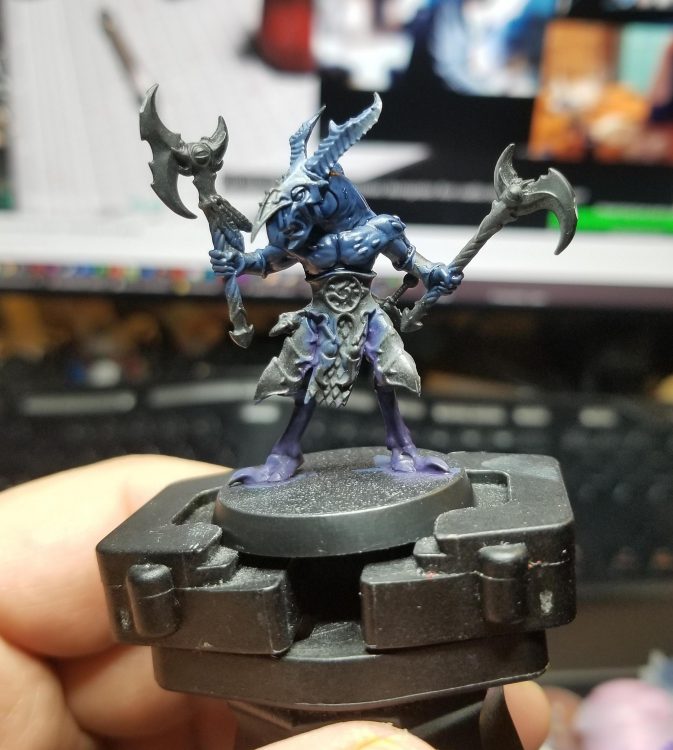
I started by painting the flesh with Citadel The Fang. I then washed the model – the top was washed with Drakenhof NIghtshade and the bottom was washed with Druchii Violet to give it more of a purple hue. I then began painted the flesh with lighter layers, painting the lower body with a mix of white and Xereus Purple and working up on the upper body with mixes of Reaper Snow Shadow and The Fang. The general process I’m using for this is basecoat -> shade -> highlight with the original basecoat -> highlight with lighter shades.
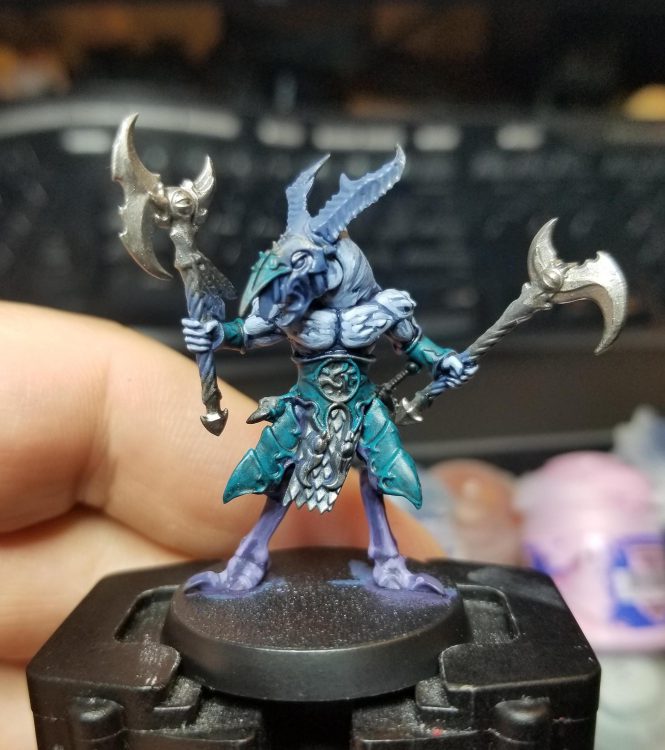
Next comes the Armor Plating. I painted the armor plates with Sotek Green, then washed it with Drakenhof Nightshade. At this step I also painted the metal bits with Leadbelcher. I’ll wash the weapons with Nuln Oil and the scale mail tabard I wanted to be brighter and look more like part of the armor, so I washed it with a Guilliman Blue gloss. They don’t make this anymore, but you can likely replicate the effect by mixing Macragge Blue or the deep blue Contrast Paint with a lot of Lahmian Medium or water.
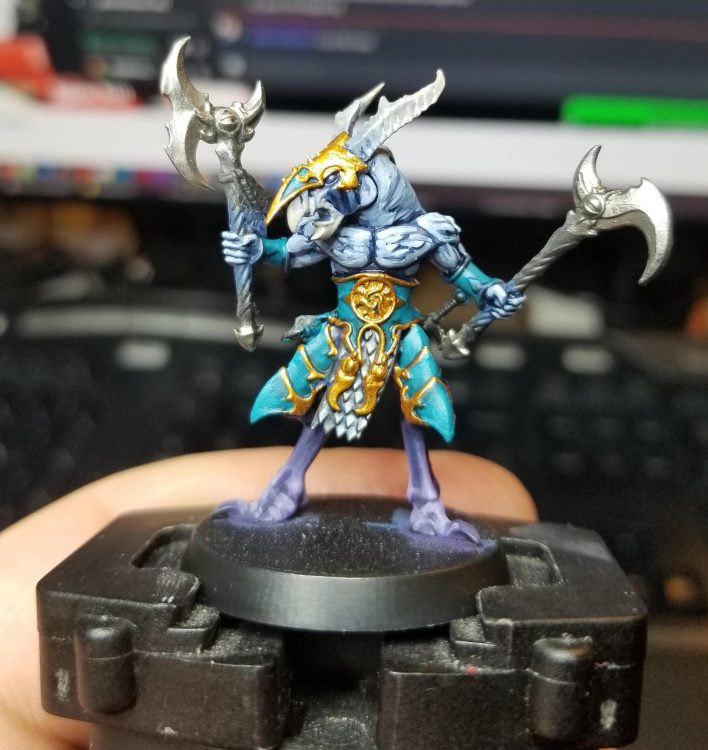
I then went back over the armor with Sotek Green again and did edge highlights of it using a mix of Sotek Green and White, though Baharroth Blue would also work for this. This step is also where I laid down the basecoat for the gold parts, using Retributor Armour Gold for the basecoat.
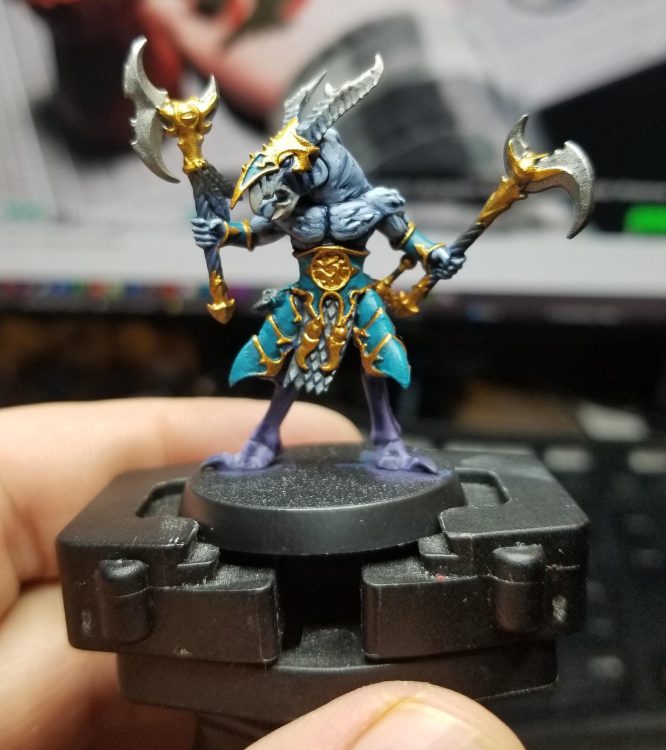
Now the bone details. I paint bone, including the talons, beak, and claws with Rakarth Flesh as the base coat. for the beak and the horns I want those to blend into the flesh, so I do a blend of Rakarth Flesh and Snow Shadow. Usually this only requires two passes, one at 2:1 Show shadow/Rakarth and another at 1:2 since they’re both off-white.
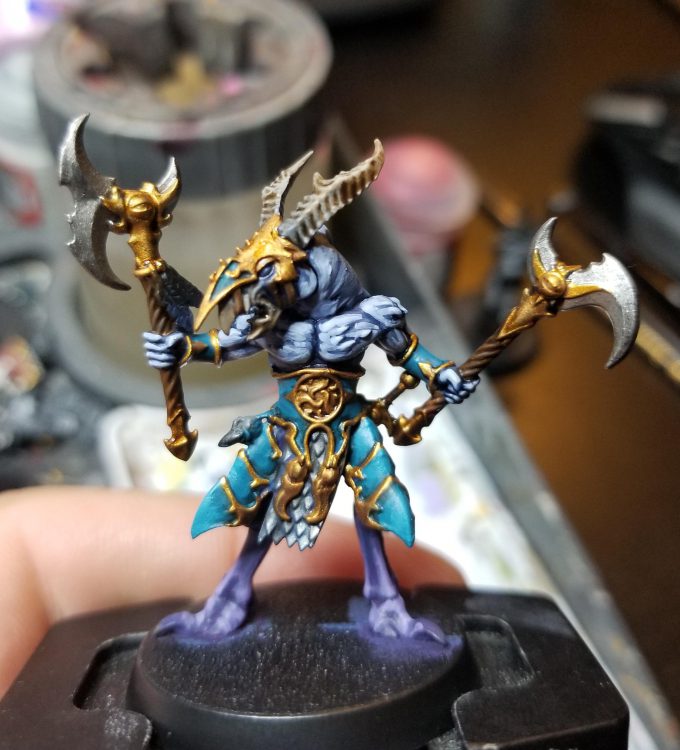
Once I’ve got the gold and bone details laid down, I wash both with Agrax Earthshade. It’s a pretty liberal application. The more you add, the older and more tarnished the metal will look. I also wash the axe blades with Nuln Oil at this point and paint the armor straps with Mournfang Brown.
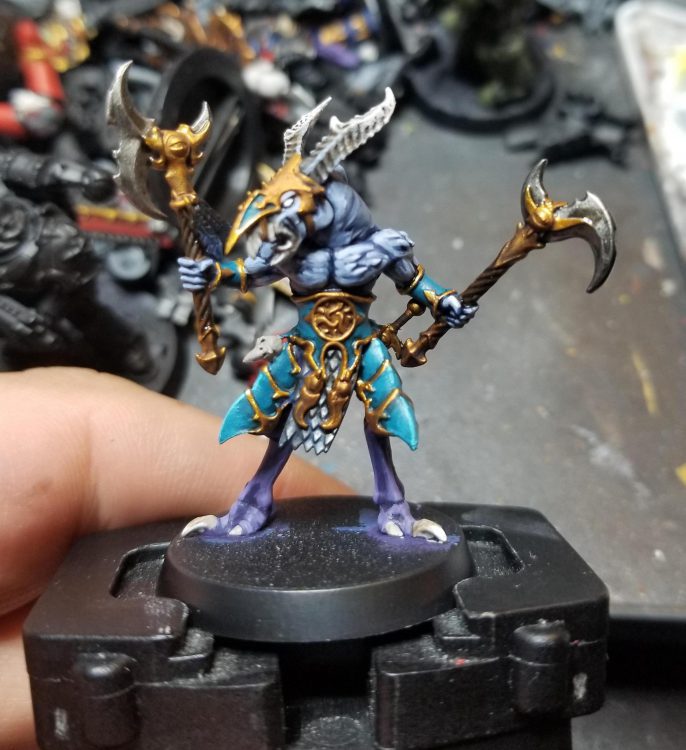
Once the Agrax Earthshade wash dries, I highlight the bones and beak with Rakarth Flesh again, and then do some edge highlighting with Reaper Polished Bone to get an even lighter shade. I edge highlight both the weapons and the scale mail with Ironbreaker or Rune Fang Steel, whichever happens to be closer to me when I’m looking for paints.I also dot the eye with Reaper Pure White.
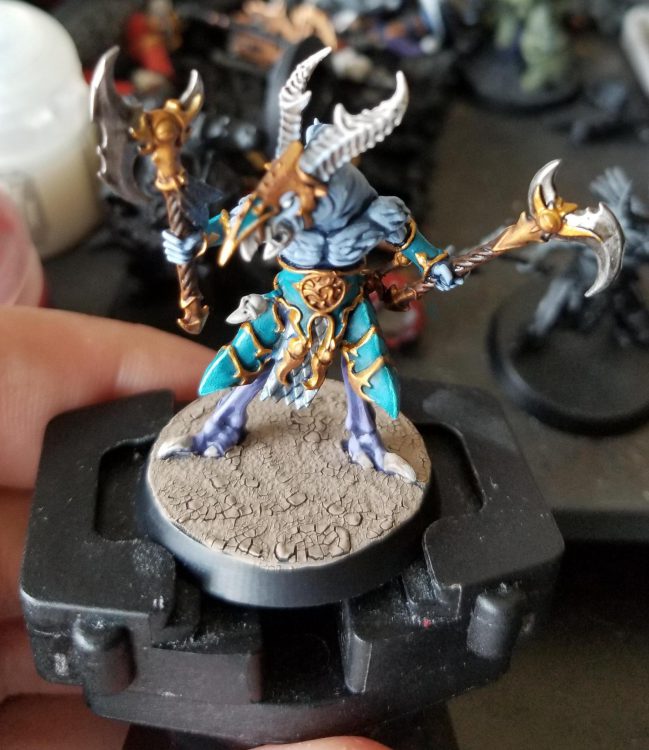
Time for basing and final details. The base I’m doing as just a big blob of Agrellan Earth, which will then crack apart and give me an easy desert badlands texture. I’ve also gotta paint the gemstones. Those I paint Mephiston Red, followed by washing the upper right portion with Carroburg Crimson. Then I add a black dot in the upper right, put a smaller white dot in that, and do a small highlight of Evil Sunz Scarlet in the lower left. Standard gemstone procedure, really. The feathers I paint Celestra Grey and then highlight with Reaper Pure White.
Once the base is dry, I drybrush it with Reaper Polished Bone and we’re good to go.
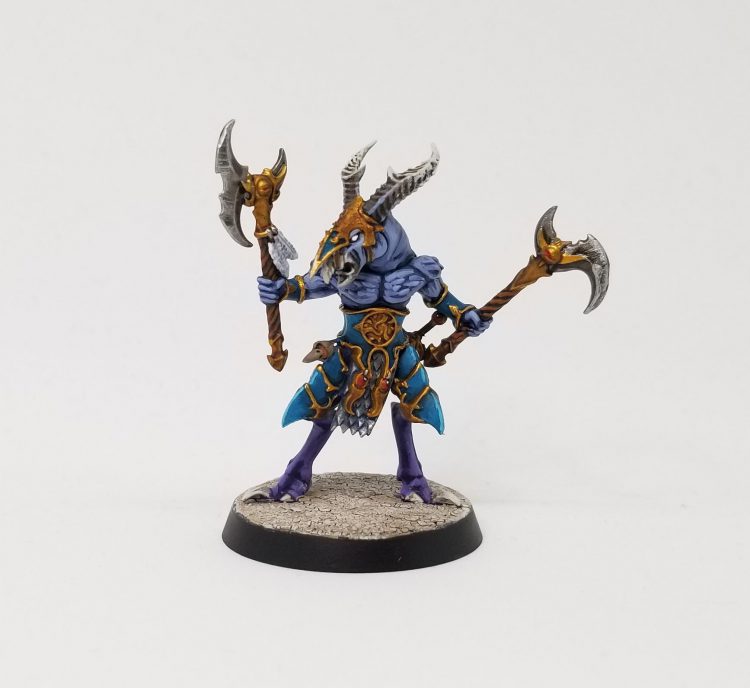
Mike’s method
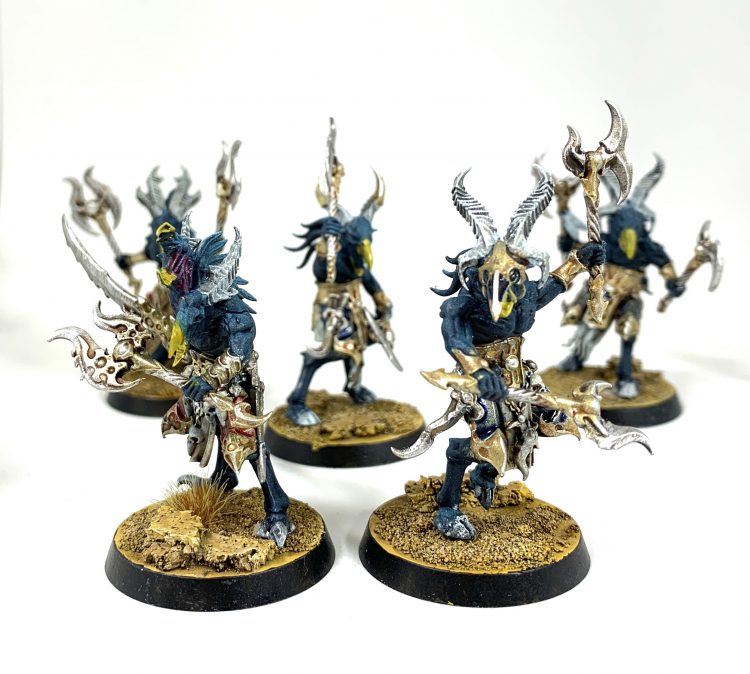
Painting the flesh:
This is a technique I used very early in my foray back in the Warhammer, and it served me well to get 20 painted up fast for my first Thousand Sons force. I started by giving the whole model a base coat of Reaper Deep Ocean, then at a higher angle (mostly from the top) a layer of Reaper Marine Teal. This was finished off with a final pass at the highest points using Reaper Surf Aqua. To bring out some further detail, I then washed all the areas that were going to stay blue with Drakenhof Nightshade.
Painting the chitin:
To paint the beaks, hooves and horns, they were both given the same initial layer of Vallejo Model Ivory. The beaks were then painted with Vallejo Model Air Yellow, which took a couple of coats to get consistent. The horns and hooves were washed with Nuln Oil, and then another high light pass was completed with the ivory to increase the contrast a little.
Painting the armour:
I took a fairly simple approach here, and used it as an opportunity to experiment with some Ghost Tints. All of the armour and weapon handles were coated with a base layer of Vallejo Metal Air Gold, followed by a wash of Reikland Fleshshade and the a drybrush of Liberator Gold. To add some colour, I alternated brushing on Ghost Tint Fresh Blood and Midnight Blue, in the recessed areas of the armour.
Painting the weapons:
The bodies of many weapons, and the larger details, were picked out using the same process as the armour. Blades were painted Vallejo Metal Air Duraluminum, washed with Agrax Earthshade and then drybrushed Duraluminum.
This entire process was pretty quick, however if I was doing them today there’s definitely different choices I’d make. I’d like to add some contrast paints to certain steps, especially for the chitin and I think I’d find a way to push the overall contrast on the flesh a little harder too. Saying all of that, my biggest takeaway was how mind-numbing batch painting more than five models is, which was probably the most important lesson I learned!
Bob “Beanith” G’s HTPE Goat/Bird Contrasting Smooshy Style
So there I was, minding my own business, innocently building my Death Guard marines and having mock battles at my desk with the chibi marine and eversor (with sounds effects) when Pvt_Snafu asked if anyone had any Tzaangors?
I said I have some from my copy of Warhammer Quest: Silver Tower… and then CLANG, down came a cage trapping me inside. Then out steps Robert “TheChirurgeon” Jones with a big pointy stick and…
Rob: None of that last paragraph was true. In fact you volunteered to help out.
Bob: Shhh, I’m taking poetic licence here. Plus I’m padding out my part of the article. Anyways, here’s my quick and simple method for churning out the 30 or so Tzaangors you’ll want for your Tzaangor Bomb/Meatshields.
- Corax White spray undercoat
- Contrast Space Wolves Grey on the skin.
- Contrast Skeleton Horde on the horns, face and feet. Extra coat on the horns to get a pooling contrast effect.
- Stormhost Silver Layer on anything you want to be particularly shiney. In this instance the bottom half of the sword, the scale mail and the gem in the shield.
- With the armor and shield, I used a pattern of Contrast Gryph-hound Orange, Contrast Blood Angel Red and the magical Contrast Iyanden Yellow.
- Paint the base of the hair with Contrast Shyish Purple and the tips with Contrast Aethermatic Blue. While you have that open, dab a little in the eyes too.
- Slop on some Agrellan Earth Texture on the base and then paint the rim Chaos black to appease the 40kBadcast Dan.
Boom, the first of thirty, or in my case 6, done.
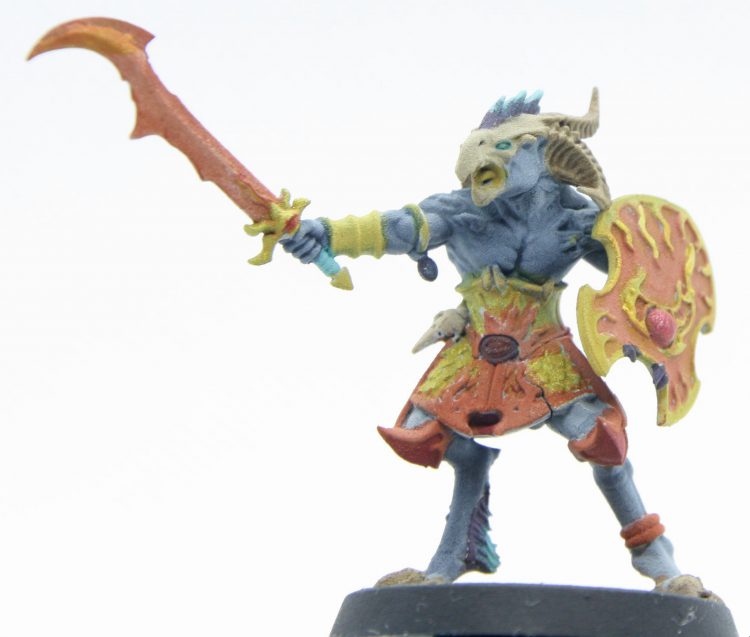
Now I’m off to rattle my water pot along the bars of my cage and…
Rob: Stop that.
Bob: POETIC LICENCE!
Muggins’ Also Contrast-y Method
My paint methods are rather pedestrian compared to some on this here site – I mostly go for tabletop quality so I can get stuff out and finished. Tzaangors happened to land on my paint table right around the time contrast paints came out, so I decided they’d be my first project.
I prime with Rustoleum Flat White and it works fine for me with contrast paints. I tend to start at the skin layer with most models, so I painted Aethermatic Blue as the skin and it really popped. I use these guys in my Beasts of Chaos army for Age of Sigmar and they really stand out – my army has always been (back to Fantasy Battle) dedicated to Tzeentch, so I have a lot of blue shades in my army, but all the beastmen so far have been barbarian flesh toned. These guys are bright turquoise so they really stand out.
After that, I painted the weapons, armor, and discs silver using Army Painter silver, and the beaks, horns, and hooves? talons? with P3 Jack Bone. Loin cloths received Contrast Snakebite Leather and other details like ditty bags, tongues, etc were picked out with various colors to show up.
The main part that I experimented with was using contrast paints over the silver colors on the disc and weapons. I used Talassar Blue over the ends of weapons, and Magos Purple, Leviadon Blue, and Volupus Pink over the discs. I have to say that Magos Purple really doesn’t show up well. I also did the Tzeentch fire underneath the bases with these colors.
I did an Army Painter Strong Tone wash over the armor, weapon parts, and disc parts that were still silver, then based with sand and blue tufts from Gamers Grass.
The Shaman is very much the same with a slight variation in that he has a large feather headdress that received some of each of the three main contrast colors I used on the discs to help him stand out a bit.
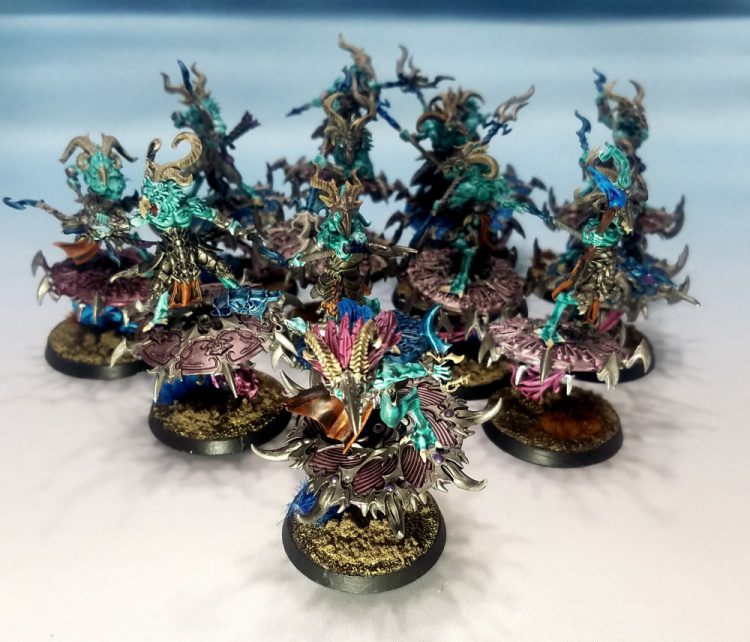
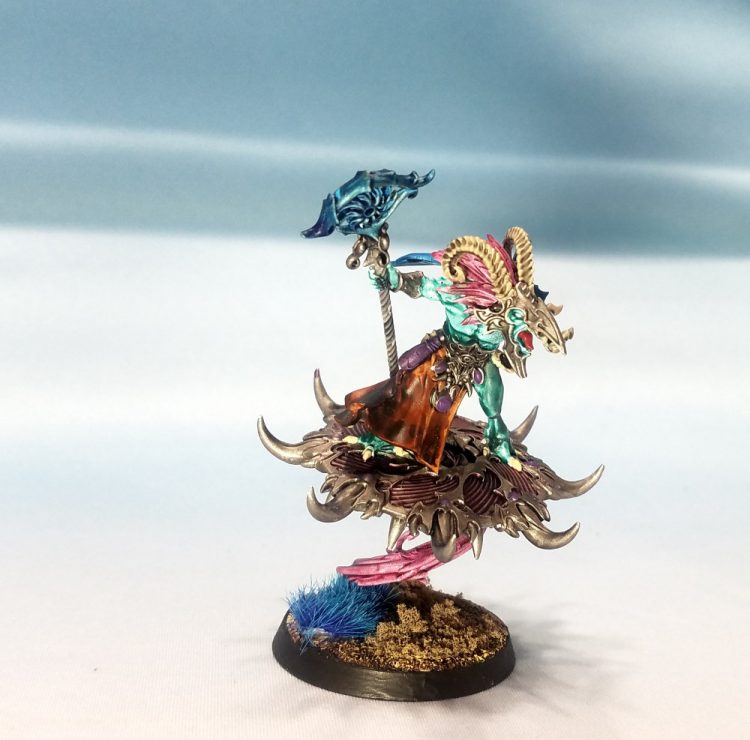
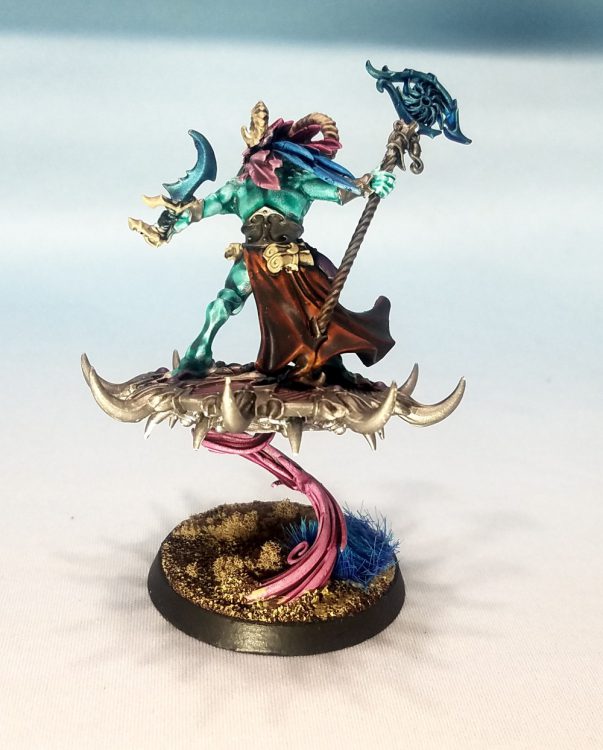
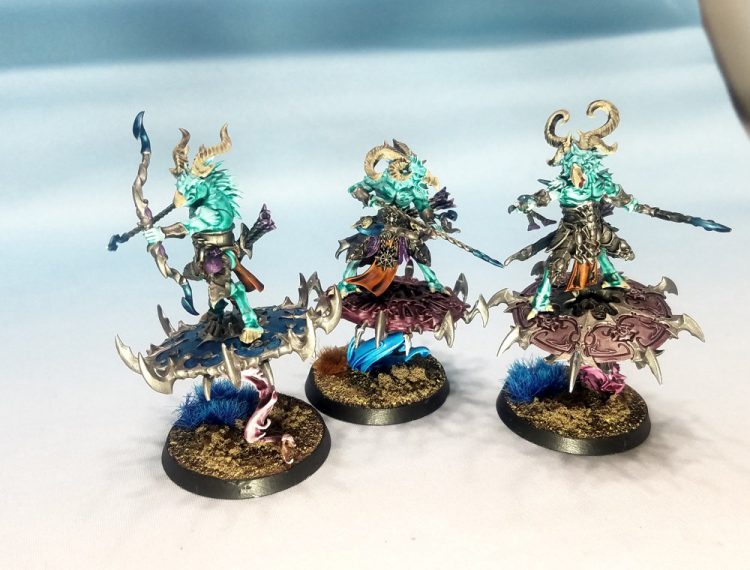
For the Changer of Ways
In Age of Sigmar, Disciples of Tzeentch are still pretty solid despite some recent balance nerfs, and Tzaangors are a cool part of that. Tzaangors may not still be the powerhouse in 40k that they were before the December 2019 FAQ, but they’re still a fun unit with a great, detailed kit. Hopefully this article has given you a few ways to approach painting a ton of these, and a few ideas on scheme. As always, if you have any questions or feedback, drop us a note in the comments below or email us at contact@goonhammer.com.

